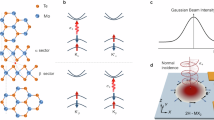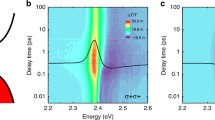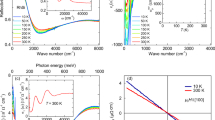Abstract
Photogalvanic effects are characterized by the presence of light-polarization-dependent non-zero short circuit photocurrent and non-zero open circuit voltage in junction-free bulk non-centrosymmetric semiconductors and metals and have been attributed to the non-trivial Berry parameters of matter. Non-centrosymmetric ferroelectric and piezoelectric halide perovskites demonstrate a coexistence of excellent semiconducting properties, switchable or tunable Berry parameters and spin–momentum locking, and strong spin–orbit coupling, making them an ideal model system to explore the photogalvanic effects, and its use in characterizing topological properties, and to develop novel devices. In this Perspective, we describe various mechanisms to break inversion symmetry in halide perovskites and present the theory and mechanisms of the linear and circular photogalvanic effect in non-centrosymmetric halide perovskites. We discuss the roles of symmetry, strain, chemistry, interface and electric polarization on the linear and circular photogalvanic effect in non-centrosymmetric halide perovskites. We present the key opportunities and challenges of designing and harnessing photogalvanic effects in non-centrosymmetric halide perovskites for unconventional devices for spin computing, sensing and solar energy applications.
This is a preview of subscription content, access via your institution
Access options
Access Nature and 54 other Nature Portfolio journals
Get Nature+, our best-value online-access subscription
$32.99 / 30 days
cancel any time
Subscribe to this journal
Receive 12 digital issues and online access to articles
$119.00 per year
only $9.92 per issue
Buy this article
- Purchase on SpringerLink
- Instant access to full article PDF
Prices may be subject to local taxes which are calculated during checkout





Similar content being viewed by others
References
Stranks, S. D. et al. Electron–hole diffusion lengths exceeding 1 micrometer in an organometal trihalide perovskite absorber. Science 342, 341–344 (2013).
Huang, P.-J., Taniguchi, K. & Miyasaka, H. Bulk photovoltaic effect in a pair of chiral–polar layered perovskite-type lead iodides altered by chirality of organic cations. J. Am. Chem. Soc. 141, 14520–14523 (2019).
Kim, M., Im, J., Freeman, A. J., Ihm, J. & Jin, H. Switchable S = 1/2 and J = 1/2 Rashba bands in ferroelectric halide perovskites. Proc. Natl Acad. Sci. USA 111, 6900–6904 (2014).
Liao, W.-Q. et al. A lead-halide perovskite molecular ferroelectric semiconductor. Nat. Commun. 6, 7338 (2015).
Shu, L. et al. Photoflexoelectric effect in halide perovskites. Nat. Mater. 19, 605–609 (2020).
Wang, Z. et al. Flexophotovoltaic effect and above-band-gap photovoltage induced by strain gradients in halide perovskites. Phys. Rev. Lett. 132, 086902 (2024).
Ye, H.-Y., Zhang, Y., Fu, D.-W. & Xiong, R.-G. An above-room-temperature ferroelectric organo-metal halide perovskite: (3-pyrrolinium)(CdCl3). Angew. Chem. Int. Ed. Engl. 53, 11242–11247 (2014).
Zhai, Y. et al. Giant Rashba splitting in 2D organic–inorganic halide perovskites measured by transient spectroscopies. Sci. Adv. 3, e1700704 (2017).
Zhang, L. et al. Room-temperature electrically switchable spin–valley coupling in a van der Waals ferroelectric halide perovskite with persistent spin helix. Nat. Photon. 16, 529–537 (2022).
Zheng, F., Takenaka, H., Wang, F., Koocher, N. Z. & Rappe, A. M. First-principles calculation of the bulk photovoltaic effect in CH3NH3PbI3 and CH3NH3PbI3−xClx. J. Phys. Chem. Lett. 6, 31–37 (2015).
Sturman, B. I. Ballistic and shift currents in the bulk photovoltaic effect theory. Phys. Uspekhi 63, 407 (2020).
Ellis, S. G. et al. Photovoltages larger than the band gap in zinc sulfide crystals. Phys. Rev. 109, 1860–1860 (1958).
Glass, A. M., von der Linde, D. & Negran, T. J. High‐voltage bulk photovoltaic effect and the photorefractive process in LiNbO3. Appl. Phys. Lett. 25, 233–235 (1974).
Goldstein, L. & Pensak, L. High-voltage photovoltaic effect. J. Appl. Phys. 30, 155–161 (1959).
Koch, W. T. H., Munser, R., Ruppel, W. & Würfel, P. Anomalous photovoltage in BaTiO3. Ferroelectrics 13, 305–307 (1976).
Asnin, V. M. et al. ‘Circular’ photogalvanic effect in optically active crystals. Solid State Commun. 30, 565–570 (1979).
de Juan, F., Grushin, A. G., Morimoto, T. & Moore, J. E. Quantized circular photogalvanic effect in Weyl semimetals. Nat. Commun. 8, 15995 (2017).
Hosur, P. Circular photogalvanic effect on topological insulator surfaces: Berry-curvature-dependent response. Phys. Rev. B 83, 035309 (2011).
Ma, C. et al. Intelligent infrared sensing enabled by tunable moiré quantum geometry. Nature 604, 266–272 (2022).
Ma, Q. et al. Direct optical detection of Weyl fermion chirality in a topological semimetal. Nat. Phys. 13, 842–847 (2017).
Ma, Q. et al. Observation of the nonlinear Hall effect under time-reversal-symmetric conditions. Nature 565, 337–342 (2019).
Olbrich, P. et al. Room-temperature high-frequency transport of Dirac fermions in epitaxially grown Sb2Te3- and Bi2Te3-based topological insulators. Phys. Rev. Lett. 113, 096601 (2014).
Osterhoudt, G. B. et al. Colossal mid-infrared bulk photovoltaic effect in a type-I Weyl semimetal. Nat. Mater. 18, 471–475 (2019).
Rees, D. et al. Helicity-dependent photocurrents in the chiral Weyl semimetal RhSi. Sci. Adv. 6, eaba0509 (2020).
Wu, Q. S., Zhang, S. N., Fang, Z. & Dai, X. Photogalvanic in ultrathin film of topological insulator. Phys. E Low Dimens. Syst. Nanostruct. 44, 895–899 (2012).
Gao, J.-X., Zhang, W.-Y., Wu, Z.-G., Zheng, Y.-X. & Fu, D.-W. Enantiomorphic perovskite ferroelectrics with circularly polarized luminescence. J. Am. Chem. Soc. 142, 4756–4761 (2020).
Jia, R. et al. Composition gradient-enabled circular photogalvanic effect in inorganic halide perovskites. Appl. Phys. Lett. 120, 211901 (2022).
Liu, X. et al. Circular photogalvanic spectroscopy of Rashba splitting in 2D hybrid organic–inorganic perovskite multiple quantum wells. Nat. Commun. 11, 323 (2020).
Liu, Y. et al. Ferroic halide perovskite optoelectronics. Adv. Funct. Mater. 31, 2102793 (2021).
Sun, Z. et al. A photoferroelectric perovskite-type organometallic halide with exceptional anisotropy of bulk photovoltaic effects. Angew. Chem. Int. Ed. Engl. 55, 6545–6550 (2016).
Sturman, B. & Fridkin, V. Photovoltaic and Photo-refractive Effects in Noncentrosymmetric Materials 1st edn (Routledge, 1992).
Nagaosa, N. & Morimoto, T. Concept of quantum geometry in optoelectronic processes in solids: application to solar cells. Adv. Mater. 29, 1603345 (2017).
Young, S. M. & Rappe, A. M. First principles calculation of the shift current photovoltaic effect in ferroelectrics. Phys. Rev. Lett. 109, 116601 (2012).
Tan, L. Z. et al. Shift current bulk photovoltaic effect in polar materials — hybrid and oxide perovskites and beyond. npj Comput. Mater. 2, 16026 (2016).
Cook, A. M., Fregoso, B. M., de Juan, F., Coh, S. & Moore, J. E. Design principles for shift current photovoltaics. Nat. Commun. 8, 14176 (2017).
Burger, A. M. et al. Direct observation of shift and ballistic photovoltaic currents. Sci. Adv. 5, eaau5588 (2019).
Fregoso, B. M., Morimoto, T. & Moore, J. E. Quantitative relationship between polarization differences and the zone-averaged shift photocurrent. Phys. Rev. B 96, 075421 (2017).
Resta, R. Macroscopic polarization in crystalline dielectrics: the geometric phase approach. Rev. Mod. Phys. 66, 899–915 (1994).
Resta, R. Modern theory of polarization in ferroelectrics. Ferroelectrics 151, 49–58 (1994).
Jiang, J. et al. Flexo-photovoltaic effect in MoS2. Nat. Nanotechnol. 16, 894–901 (2021).
Ganichev, S. D. & Prettl, W. Intense Terahertz Excitation Semiconductors (Clarendon Press, 2005).
Bernevig, B. A., Orenstein, J. & Zhang, S.-C. Exact SU(2) symmetry and persistent spin helix in a spin–orbit coupled system. Phys. Rev. Lett. 97, 236601 (2006).
Dresselhaus, G. Spin–orbit coupling effects in zinc blende structures. Phys. Rev. 100, 580–586 (1955).
Rashba, E. I. & Sheka, V. I. Symmetry of energy bands in crystals of wurtzite type II. Symmetry of bands with spin–orbit interaction included. New J. Phys. 17, 050202 (2015).
Ding, K. et al. Superior ferroelectricity and nonlinear optical response in a hybrid germanium iodide hexagonal perovskite. Nat. Commun. 14, 2863 (2023).
Ding, R. et al. Effective piezo-phototronic enhancement of flexible photodetectors based on 2D hybrid perovskite ferroelectric single-crystalline thin-films. Adv. Mater. 33, 2101263 (2021).
Ji, C. et al. Bandgap narrowing of lead-free perovskite-type hybrids for visible-light-absorbing ferroelectric semiconductors. J. Phys. Chem. Lett. 8, 2012–2018 (2017).
Pan, Q. et al. A three-dimensional molecular perovskite ferroelectric: (3-ammoniopyrrolidinium)RbBr3. J. Am. Chem. Soc. 139, 3954–3957 (2017).
Park, I.-H. et al. Self-powered photodetector using two-dimensional ferroelectric Dion–Jacobson hybrid perovskites. J. Am. Chem. Soc. 142, 18592–18598 (2020).
Sha, T.-T. et al. Fluorinated 2D lead iodide perovskite ferroelectrics. Adv. Mater. 31, 1901843 (2019).
Stroppa, A. et al. Tunable ferroelectric polarization and its interplay with spin–orbit coupling in tin iodide perovskites. Nat. Commun. 5, 5900 (2014).
Wang, C. et al. Two-dimensional (n = 1) ferroelectric film solar cells. Natl Sci. Rev. 10, nwad061 (2023).
Wei, W. et al. The first 2D organic–inorganic hybrid relaxor-ferroelectric single crystal. Sci. China Chem. 66, 466–474 (2023).
Zheng, W. et al. Emerging halide perovskite ferroelectrics. Adv. Mater. 35, 2205410 (2023).
Chang, G. et al. Topological quantum properties of chiral crystals. Nat. Mater. 17, 978–985 (2018).
Iwasaki, H., Miyazawa, S., Koizumi, H., Sugii, K. & Niizeki, N. Ferroelectric and optical properties of Pb5Ge3O11 and its isomorphous compound Pb5Ge2SiO11. J. Appl. Phys. 43, 4907–4915 (1972).
Aglagul, D. & Shi, J. Strain-induced Kramers–Weyl phase in III–V zinc blende systems. Appl. Phys. Lett. 126, 083102 (2025).
Hu, Y. et al. A chiral switchable photovoltaic ferroelectric 1D perovskite. Sci. Adv. 6, eaay4213 (2020).
Niesner, D. et al. Structural fluctuations cause spin-split states in tetragonal (CH3NH3)PbI3 as evidenced by the circular photogalvanic effect. Proc. Natl Acad. Sci. USA 115, 9509–9514 (2018).
Ai, Y., Lv, H.-P., Wang, Z.-X., Liao, W.-Q. & Xiong, R.-G. H/F substitution for advanced molecular ferroelectrics. Trends Chem. 3, 1088–1099 (2021).
Cai, Y., Chippindale, A. M., Curry, R. J. & Vaqueiro, P. Multiple roles of 1,4-diazabicyclo[2.2.2]octane in the solvothermal synthesis of iodobismuthates. Inorg. Chem. 60, 5333–5342 (2021).
Son, J. et al. Unraveling chirality transfer mechanism by structural isomer-derived hydrogen bonding interaction in 2D chiral perovskite. Nat. Commun. 14, 3124 (2023).
Xie, Y. et al. The soft molecular polycrystalline ferroelectric realized by the fluorination effect. J. Am. Chem. Soc. 142, 12486–12492 (2020).
Yang, C.-K. et al. The first 2D homochiral lead iodide perovskite ferroelectrics: [R- and S-1-(4-chlorophenyl)ethylammonium]2PbI4. Adv. Mater. 31, 1808088 (2019).
Zhang, W.-Y. et al. Precise molecular design of high-Tc 3D organic–inorganic perovskite ferroelectric: [MeHdabco]RbI3 (MeHdabco = N-methyl-1,4-diazoniabicyclo[2.2.2]octane). J. Am. Chem. Soc. 139, 10897–10902 (2017).
Zhang, Y. et al. Ferroelectricity induced by ordering of twisting motion in a molecular rotor. J. Am. Chem. Soc. 134, 11044–11049 (2012).
Zhao, X.-M. et al. Polar molecule-based material with optic–electric switching constructed by polar anions. Inorg. Chem. 59, 5475–5482 (2020).
Ai, Y. et al. Fluorine substitution induced high Tc of enantiomeric perovskite ferroelectrics: (R)- and (S)-3-(fluoropyrrolidinium)MnCl3. J. Am. Chem. Soc. 141, 4474–4479 (2019).
Jach, E. et al. Dynamics of organic cations in switchable quinuclidinium metal chloride dielectrics. J. Phys. Chem. C 127, 2589–2602 (2023).
Wojcik, N. A. et al. Tunable dielectric switching of (quinuclidinium)[MnCl4] hybrid compounds. J. Phys. Chem. C 125, 16810–16818 (2021).
Jung, M.-H. The dual band and white-light emission from piperazine halide perovskites. CrystEngComm 24, 1413–1423 (2022).
Liu, G. et al. Thermally induced reversible double phase transitions in an organic–inorganic hybrid iodoplumbate C4H12NPbI3 with symmetry breaking. Inorg. Chem. 55, 8025–8030 (2016).
Zhang, H.-Y. et al. Methylphosphonium tin bromide: a 3D perovskite molecular ferroelectric semiconductor. Adv. Mater. 32, 2005213 (2020).
Liu, Y. et al. Giant polarization sensitivity via the anomalous photovoltaic effect in a two-dimensional perovskite ferroelectric. J. Am. Chem. Soc. 145, 16193–16199 (2023).
Yuan, Y. et al. Anomalous photovoltaic effect in organic–inorganic hybrid perovskite solar cells. Sci. Adv. 3, e1602164 (2017).
Koralek, J. D. et al. Emergence of the persistent spin helix in semiconductor quantum wells. Nature 458, 610–613 (2009).
Walser, M. P., Reichl, C., Wegscheider, W. & Salis, G. Direct mapping of the formation of a persistent spin helix. Nat. Phys. 8, 757–762 (2012).
Jana, M. K. et al. Structural descriptor for enhanced spin-splitting in 2D hybrid perovskites. Nat. Commun. 12, 4982 (2021).
Chen, R. et al. Ferroelectric CsGeI3 single crystals with a perovskite structure grown from aqueous solution. J. Phys. Chem. C 127, 635–641 (2023).
Chen, Z. et al. Searching for circular photo galvanic effect in oxyhalide perovskite Bi4NbO8Cl. Adv. Funct. Mater. 32, 2206343 (2022).
Swift, M. W. & Lyons, J. L. Lone-pair stereochemistry induces ferroelectric distortion and the Rashba effect in inorganic halide perovskites. Chem. Mater. 35, 9370–9377 (2023).
Zhang, Y. et al. Ferroelectricity in a semiconducting all-inorganic halide perovskite. Sci. Adv. 8, eabj5881 (2022).
Smith, E. H., Benedek, N. A. & Fennie, C. J. Interplay of octahedral rotations and lone pair ferroelectricity in CsPbF3. Inorg. Chem. 54, 8536–8543 (2015).
Hua, L. et al. Acquiring bulk anomalous photovoltaic effect in single crystals of a lead-free double perovskite with aromatic and alkali mixed-cations. Small 19, 2207393 (2023).
Lei, Y. et al. Bulk photovoltaic effect of a hybrid ferroelectric semiconductor. Phys. Rev. B 109, 104110 (2024).
Spanier, J. E. et al. Power conversion efficiency exceeding the Shockley–Queisser limit in a ferroelectric insulator. Nat. Photon. 10, 611–616 (2016).
Pusch, A., Römer, U., Culcer, D. & Ekins-Daukes, N. J. Energy conversion efficiency of the bulk photovoltaic effect. PRX Energy 2, 013006 (2023).
Jiang, J., Pendse, S., Zhang, L. & Shi, J. Strain related new sciences and devices in low-dimensional binary oxides. Nano Energy 104, 107917 (2022).
Schlom, D. G. et al. Elastic strain engineering of ferroic oxides. MRS Bull. 39, 118–130 (2014).
Liu, S., Kim, Y., Tan, L. Z. & Rappe, A. M. Strain-induced ferroelectric topological insulator. Nano Lett. 16, 1663–1668 (2016).
Yang, M.-M., Kim, D. J. & Alexe, M. Flexo-photovoltaic effect. Science 360, 904–907 (2018).
Guo, H., Li, Z. J., Kim, S. C., Han, G. S. & Jung, H. S. Strain in halide perovskite solar cells: origins, impacts, and regulation. Sol. RRL 8, 2400203 (2024).
Zhu, C. et al. Strain engineering in perovskite solar cells and its impacts on carrier dynamics. Nat. Commun. 10, 815 (2019).
Du, T. et al. Additive-free, low-temperature crystallization of stable α-FAPbI3 perovskite. Adv. Mater. 34, 2107850 (2022).
Li, J. & Haney, P. M. Circular photogalvanic effect in organometal halide perovskite CH3NH3PbI3. Appl. Phys. Lett. 109, 193903 (2016).
Xiao, Z. et al. Giant switchable photovoltaic effect in organometal trihalide perovskite devices. Nat. Mater. 14, 193–198 (2015).
Zhang, S. et al. Moiré superlattices in twisted two-dimensional halide perovskites. Nat. Mater. 23, 1222–1229 (2024).
Ji, Z. et al. Photocurrent detection of the orbital angular momentum of light. Science 368, 763–767 (2020).
Huang, P.-J. et al. Chirality-dependent circular photogalvanic effect in enantiomorphic 2D organic–inorganic hybrid perovskites. Adv. Mater. 33, 2008611 (2021).
Zhu, Z. et al. Metal halide perovskites: stability and sensing-ability. J. Mater. Chem. C 6, 10121–10137 (2018).
Cai, Y. et al. A van der Waals photo-ferroelectric synapse. Adv. Electron. Mater. 8, 2200326 (2022).
Gou, G., Young, J., Liu, X. & Rondinelli, J. M. Interplay of cation ordering and ferroelectricity in perovskite tin iodides: designing a polar halide perovskite for photovoltaic applications. Inorg. Chem. 56, 26–32 (2017).
Lopez-Varo, P. et al. Physical aspects of ferroelectric semiconductors for photovoltaic solar energy conversion. Phys. Rep. 653, 1–40 (2016).
Gao, Y. et al. Molecular engineering of organic–inorganic hybrid perovskites quantum wells. Nat. Chem. 11, 1151–1157 (2019).
Bartel, C. J. et al. New tolerance factor to predict the stability of perovskite oxides and halides. Sci. Adv. 5, eaav0693 (2019).
Ünlü, F. et al. Understanding the interplay of stability and efficiency in A-site engineered lead halide perovskites. APL Mater. 8, 070901 (2020).
Acknowledgements
J.B. acknowledges support from the European Research Council under the European Union’s Horizon 2020 research and innovation programme (Grant Agreement No. 101001626). J.S. acknowledges the support from US AFOSR under award number FA9550-23-1-0310; the US National Science Foundation under Award Nos 2024972, 2031692 and 2312944; and New York State’s Empire State Development’s Division of Science Technology and Innovation through Focus Center Contract No. C180117.
Author information
Authors and Affiliations
Contributions
All authors contributed to the writing of the manuscript equally.
Corresponding authors
Ethics declarations
Competing interests
The authors declare no competing interests.
Peer review
Peer review information
Nature Reviews Physics thanks the anonymous reviewers for their contribution to the peer review of this work.
Additional information
Publisher’s note Springer Nature remains neutral with regard to jurisdictional claims in published maps and institutional affiliations.
Rights and permissions
Springer Nature or its licensor (e.g. a society or other partner) holds exclusive rights to this article under a publishing agreement with the author(s) or other rightsholder(s); author self-archiving of the accepted manuscript version of this article is solely governed by the terms of such publishing agreement and applicable law.
About this article
Cite this article
Briscoe, J., Shi, J. Photogalvanic effects in non-centrosymmetric halide perovskites. Nat Rev Phys 7, 270–279 (2025). https://doi.org/10.1038/s42254-025-00822-8
Accepted:
Published:
Issue date:
DOI: https://doi.org/10.1038/s42254-025-00822-8



